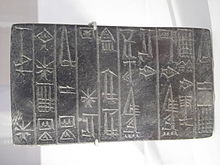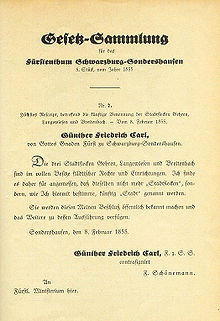Certificate
A certificate (from Old High German urchundi "knowledge"; Middle High German urkúnde "certificate", "proof") is a written and often certified declaration that fixes a certain fact or fact and usually also reveals its issuer .
This primarily includes documents . Public documents in particular that have been issued by an authority or by a person with public faith ( notary , bailiff , registrar , civil engineer ) within their business area have evidential value . Important declarations (e.g. wills ) and contracts can therefore be notarized. In the case of land purchase contracts, certification by a notary is required by law, i.e. it is mandatory. The notary documents the documents certified by him in his consecutively numbered document roll .
history
The examination of documents in the interest of gaining historical knowledge is the subject of diplomacy .
In the Imperium Romanum , in addition to the documents of the state authorities, documents from public scribes ( tabellations ) and documents that were recorded in the roles of the communities ( gesta municipalia ) enjoyed public credibility.
A typical form of the design of private documents in Roman antiquity are double-written document texts: One version of the text was written on the inside on wax tablets or papyrus sealed behind a seal , another - usually more concise - on the outside of the script. As long as the seals were not destroyed, the correctness of the outer text could be checked at any time on the inner text.
While in ancient Roman society the writing was generally so high that signatures could certify the document text, other forms of certification became common in the Middle Ages . For more details see under documents of the Middle Ages and the early modern period .
The formats of the documents varied on the one hand according to the historical epoch, on the other hand also according to their legal significance. Today the A4 format dominates .
Features of a certificate in law
The law does not use the concept of certificate uniform. It is important to distinguish between the material and the procedural term of a document .
In substantive criminal law , the document is defined as an embodied statement of thought , which is suitable and intended as evidence in legal transactions and allows an issuer to be identified. Embodiment means that the documentary substance must not be volatile (perpetuation function, missing e.g. in writing in the sand). The explanation of the thoughts must also be visually perceptible so that, for example, a tape recording cannot be a certificate.
Suitability for evidence means that the document in a process can at least in principle - even if it only has a say - influence the decision and should also, according to the will of the exhibitor (evidence function, determination of evidence). At least one exhibitor must emerge from it as a specific person (guarantee function), whereby it is sufficient that its existence can be inferred from external circumstances (including the beer mat with the pencil marks). The document is false - with the consequence that the offense of forgery of the document is possible - if the recognizable issuer (as can be seen from the document) is not identical to the real issuer. For the status of an exhibitor it depends on who is behind the certificate (spirituality theory), e.g. B. the business owner for the receipt issued by the cashier .
A document in the procedural sense is any expression of thought embodied in written characters that is suitable and intended as evidence in legal transactions and allows an issuer to be recognized.
A distinction is made between effective documents and attesting documents. Acting documents directly contain the process that is to be proven by the document (e.g. judgment, administrative act , purchase contract , will ). The content of attesting documents are processes outside of the document, which are the perception or own actions of the authority or the person of public faith (e.g. minutes of meetings, protest of bills of exchange ).
Evidential value of private and public documents
In civil proceedings , according to German law, a distinction is made between private and public documents with regard to their probative value . Public documents are documents that are issued by a public authority within the limits of their official powers or by a person with public faith (e.g. notary , consul , bailiff , in Austria also civil engineer ) within the business group assigned to it in the prescribed form ( so-called authentication ). Documents drawn up by a person without public faith are called private documents (e.g. written purchase contract , handwritten will ). However, if a sales contract is notarized, a public deed is created.
Authenticity of the document
A document is authentic when the embodied explanation of thought comes spiritually from the person from whom it is represented. A certificate is not authentic if it does not originate from the person who is the issuer of it.
Domestic public documents carry proof of authenticity ( § 437 ZPO ). The court, on the other hand, has to assess the authenticity of a foreign document according to the circumstances of the individual case, unless it has been legalized by a federal consul . A legalized foreign public document is therefore equivalent to a domestic one in terms of its evidential value as to its authenticity.
However, the evidencing party has to prove the authenticity of a private document. The opponent of the evidence has to explain the authenticity of the document beforehand.
Truth of content of the document
A public document not only carries the proof of authenticity, but also proves, within certain limits, the truth of the content of the process documented in it according to § 415 ZPO. Only the correctness of the authentication is proven (formal evidential value). The formal evidential value includes that the declaration was made in terms of content, place and time as certified. The extent to which the certified declaration corresponds to reality (material evidential value), on the other hand, is subject to the free assessment of the court.
As a rule, full evidence of a fact attested to in a public document is only provided if the certificate is based on the authority's own perception or the notifying person ( Section 418 ZPO). With such a testifying document, the formal evidential value has an important function.
Example: The minutes of the meeting not only prove that the official who is named as the issuer on the minutes of the meeting has actually drawn up the minutes. This document also proves that the content of the minutes corresponds to the content of the hearing and that the minutes were made at the place and time specified in the document (formal evidential value). On the other hand, whether the presentation of the parties to the proceedings recorded in the minutes is true (material evidential value) is at the discretion of the court.
Example: A friend's confirmation that a letter has been placed in the mailbox only proves that the friend actually made this declaration. The poster's certificate of delivery for the same process, on the other hand, proves that the letter was actually posted.
The public documents issued by an authority and containing an official order, order or decision substantiate full evidence of their content ( § 417 ZPO). In the case of an effective document, the formal evidential value is almost a matter of course.
Example: A tax bill proves that it was issued by the official who created it (authenticity), that the tax bill has the specified content and was issued at the specified place and time (formal evidential value). The free assessment of the court, however, is subject to whether the tax assessment is factually correct.
The content of a private document is the subject of free judicial evidence.
Existence of the certificate
To what extent a defect in the intact existence of a document, such as B. an etching or a strike-through, which reduces the evidential value of the document, decides in the event of a dispute the called and competent court after assessing the individual case.
Examples of certificates
- Documents concerning persons:
- Documents concerning things:
- Land purchase agreement
- official land register printout
- official commercial register printout
- Securities
- Certificate of incorporation z. B. for an association or a company
- Price tag on goods (only if the name of the exhibitor can be recognized)
- Documents relating to rights
See also
literature
- Thomas Frenz: Certificate (legal) . In: Adalbert Erler et al. (Hrsg.): Concise dictionary for German legal history . Volume 5: Penal Theory - Zycha. Register . Erich Schmidt Verlag, Berlin 1998, ISBN 3-503-00015-1 , Sp. 574-576.
- Rita Heinrichs: Evidence and identification: an investigation into the concept of documents in criminal law. Aachen-Mainz 1996, ISBN 978-3-89653-028-8 .
- Ulrich Lehmann: The document report in criminal proceedings (Writings on procedural law 251). Duncker & Humblot, Berlin 2018, ISBN 978-3-428-15556-9 .
- Thomas Vogtherr : Documents and files . In: Michael Maurer (Ed.): Outline of the historical sciences . Volume 4: Sources . Reclam-Verlag, Stuttgart 2002, ISBN 3-15-017030-3 , ( Universal-Bibliothek 17030), pp. 146-167.
- Tilo Werner: Certificate . In: Gert Ueding (Hrsg.): Historical dictionary of rhetoric . Volume 9: St - Z . Max Niemeyer Verlag, Tübingen 2009, ISBN 978-3-484-68109-5 , Sp. 934-941.


